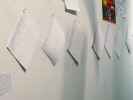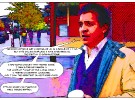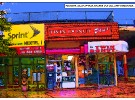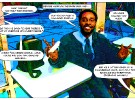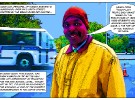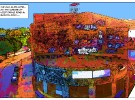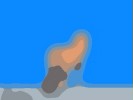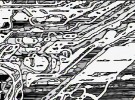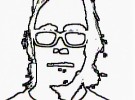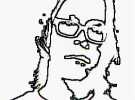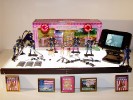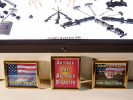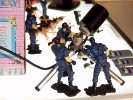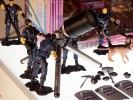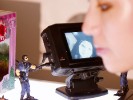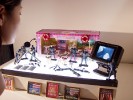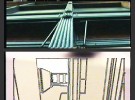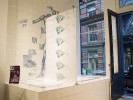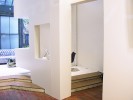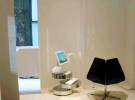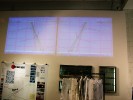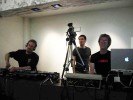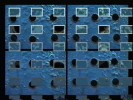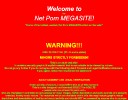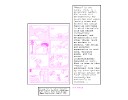Presented at the Bronx River Art Center as part of the goup exhibit Metro Poles, Art in Action, a curatorial collaboration between tne Jamaica Center for Arts & Learning (JCAL), the Bronx River Art Centre (BRAC), the Asian American Arts Center (AAAC), and the Maiden Lane Exhibition Space. The work is intended to explore the Bronx, the neighborhood of West Farms, the area’s relationship to the gallery, and the premise of the exhibit.
Here is the comic, in its entirety:
Â
Project Description:
Because this group exhibit is intended to focus on process, blur lines between artworks, and reduce the primacy of the individual artist in favor of a loose integrated net of creativity that blankets the entire gallery – even the act of writing a statement about the individual work could be seen to detract from the exhibit’s mission.
What follows is therefore, not a concise statement but rather a description of participation.
In the spring of this year I was invited by Jose Ruiz, curator of Bronx River Art Centre (BRAC) and Heng-Gil Han, curator for the Jamaica Center for Arts & Learning (JCAL), to submit responses to a set of questions.
They were asking a variety of artists to respond to the idea of an exhibit where artists would make work in a gallery setting and then have it subsequently altered by others. Among the questions asked were: “What contribution can you make to this unconventional exhibition?”, “Can you allow other artists to revise your installation?”, and “Who would be other artists that you would like to invite to the exhibition for the revision and collective art-making?”
The resulting exhibit: “Metro Poles, Art in Action”, is a curatorial collaboration with Jamaica Center for Arts & Learning (JCAL), the Bronx River Art Centre (BRAC), the Asian American Arts Center (AAAC), and the Maiden Lane Exhibition Space.
Â
Among the things I wrote back in my initial response were the following:
“I will photograph in or near the display space – i.e. nearby buildings, back yards, whatever. The available views will function as a filter or organizing principle. This will become the target of research.”
“I will then go out on the street and find anecdotal information from passersby (as well as from people employed by the art institution) regarding who lives there, what business is conducted, what events have been witnessed etc.”
“In a third step I will do further historical research about the visually identified locations on-line. I will then make a collage from the various information materials, printed with ink jet, in a variety of sizes and textures of paper and post the information on the galley walls, like fliers or even gorilla-style like paper street art.”
“All this material, both the physical printing on paper and the conceptual structure surrounding it would then be available as raw materials to use by subsequent artists in any way they see fit. I would simply hope they might function as a launching off point of interest in the creative process going forward.”
I also invited artists Chang-Jin Lee, Marcy Brafman, and Ã…sa Elzén to be “team members” for our group, one of seven groups to work in the space.
For my part I ultimately adopted six strategies, relating to my initial proposal that were designed to explore the Bronx, West Farms, (the neighborhood where BRAC is located), and the area’s relationship to the gallery and the mission of the exhibit.
Â
Strategy One: Gathering images based on a net search for the word “Bronx”
This was a way to begin to understand the visual history in relation to what people have recorded on the internet, about the Bronx.
This doesn’t constitute a comprehensive compendium of visual material for two reasons. First, many things visual known and recorded were done by people prior to the world wide web and those people tend to be less connected, and thus fail to get their visual info recorded to a web readable format, and posted. As a result, much of this human visual archive is missing from a current search.
Secondly, visual searches are still in the dark ages of technology, or in their infancy. Most digital visual images must be “tagged” with text either in their name, metadata (invisible information attached to the digital visual file) or through some similar structure, in order to show up in a search. Smart search engines may also give some weight to images on web pages titled with the search term or in which text containing the term is laid out in close proximity to an image, but this is obviously a tricky mix to accomplish successfully and thus leaves out much of the valuable information that actually has been posted, but hasn’t yet been tagged.
There are algorithms (the most effective of which are currently mostly available only to large corporations), which can search for the actual visual elements of an image, or its genuine “mediatic criteria”, such as color, luminance etc. These can find an image no matter what it has been tagged, but even these currently cutting edge technologies can only look for an image once they already have a base image to compare, so they can find close matches, but only to images they already know about.
All this means that right now, doing a visual search on the Bronx yields a strikingly limited set of results. Nonetheless, it begins to tell some stories about what people, corporations, and organizations valued enough to tag and post.
To display I printed a selection of the results, 16 images to a page, on 8 1/2″ x 11″ ink jet paper, along with the name of each file displayed below it, on 18 pages, and taped them to the gallery wall, much as I might do in my studio.
Â
Strategy Two: Download text related to the history of the Bronx and the neighborhood of West Farms.
I chose 9 of the most compelling texts among many dozen I had saved, formatted them in a formal structure designed to be reminiscent of poems, and pinned these to the wall.
In most cases, the written work was stripped to ASCII text, every comma was removed and converted to a carriage return, and every period was removed and converted to two carriage returns, to create text block separations, and finally the entire text was hard wrapped to 35 characters, to produce short phrases. I did a bit of clean up for readability, printed the texts and push pinned them to the wall.
The texts cover a range of subjects from how the Bronx got its name to the demographics and transportation structure of West Farms.
Â
Strategy Three: Non-linear story telling, through the use of Comics
I have little connection to the world of comics, and never read them as a kid. I came at the format from video art, looking for a way to accomplish similar results, but in a form that allows the viewer more leeway in the amount of time they devote to the process. Still images allow more immediate intake.
The text for the comics comes not from the net research, (as is the case with many of my past projects) but from things that people actually said to me. This is combined with photos that are digitally reworked to become a sort of cartoon or comic book, printed in non archival inks on 13″x19″ mat ink jet paper and pinned to the gallery wall. Various walks as well as interviews with gallery staff and local patrons provided the materials. Some responses also came from emailed questions to specific participants.
Â
Strategy Four: Mapping and modeling the neighborhood
Using a data projector I traced a street map of the entire neighborhood of west Farms onto a big 8′ x 10′ piece of paper and then cut the map roughly out of the center of it and pinned it to the gallery wall. I then recorded impressions about the neighborhood and where I met the people who became part of the comic.
Using a ground plan of the BRAC gallery I made a quick 3D computer model of the space and recorded where the first elements of the project were placed in the space.
I photographed part of an MTA subway map with my phone, showing West Farms, then emailed it to BRAC while on route to the gallery. Once there, I had them print the email with the map and posted it with the other mapping elements. This related to the personal nature of the work and to the idea of the documentarist or participant-observer including information about themselves within the surroundings being documented.
In the same vein, I downloaded an app to my mobile phone allowing me to track my GPS location and record in real time to a version of Google Maps. I posted a printout of one particular tracking event documenting my crossing of the entire length of West Farms, when the MTA train I was taking to the gallery went express and passed my intended stop. I thought, “This must happen all the time, when you live in West Farms.”
Â
Strategy Five: Incorporation with other works.
I placed an old laptop within an arrangement of refuse, which another artist had put together. The computer displays the text from the “poems” I had created from the earlier documentary material, and so creates another avenue of historical communication, and also relates to the work it is situated in by referring to the problem of e-waist.
I Added text comments to artist Marcy Brafman’s work, in the areas where the public is invited to participate.
I filled in several blanks in mad libs left on the walls by another artist.
I created a stick figure comic from one of the many works on paper strewn throughout the gallery, referring to both that work and other art in the gallery, using text from a visitor as inspiration, and which questions what constitutes art.
Â
Strategy 6: Blog and website. I created a blog to document my own progress so that other artists could see what was happening, and am also posting materials to this site.
http://west-farms-studio.blogspot.com/
Single channel, framed, wall mounted, 4 second loop, video work. 8 1/2″h x 11 1/2″w x 1 1/2″d Presented at the Heskin Contemporary gallery as part of the group exhibit Meet Cute curated by Elizabeth Heskin & Marcy Brafman.
Eromenia, explores contemporary East/West cultural constructions of sex, commodification, and idealization, in a way that embraces nostalgia and at the same time questions how much value people can actually receive from delusions of eros.
Â
Photo Documentation:
Â
Video Documentation:
[tubepress mode=’playlist’, playlistValue=’259B7AED291DCF58′]
Project Description:
The piece is made from advertisements for software designed to create “sexy” soft-core porn images which pop up on a computer’s desktop as a kind of “pleasant distraction”. In the case of Eromenia, the image is captured and memorialized in a small wooden frame designed to suggest the kind of keepsake photographs typically found in a middle aged Western male’s den or home office.
The image, made from a gif of only a very small number of pixels, has been further smoothed and simplified to erase all recognition of the original form, yet the movement is still utterly clear – some kind of fetching, erotic rocking or swaying.
The title of the work is intended to sound like the name of a Greek Goddess or Muse such as Eidyia, Ilithyia, Eunomia, or Urania and to evoke Erato the Muse of love and erotic poetry.
It is also intended to evoke two other notions: the late 20th century Japanese phenomenon of “Eromanga” and the long-standing Western clinical notion of “Erotomania.”
“Eromanga” is also referred to as “Hentai”, the Japanese word originally meaning “metamorphosis” or “abnormality”. In Japan “hentai” has a strong negative connotation, and is commonly used to mean “sexually perverted”. The term is used as slang for sexually explicit or pornographic pop culture imagery. Manga, the Japanese word for comics, along with the prefix “ero” (erotic) creates a wordplay, indicating perverted comics or animation.
Mania is a severe medical condition characterized by extremely elevated mood, energy, and unusual thought patterns. The experience of mania is often quite unpleasant and sometimes disturbing, and may lead to impulsive behavior, frustration, and decreased ability to communicate. Severe forms of mania cause impairment.
Erotomania is a form of the disorder in which a person holds a delusional belief that another person, usually of a higher social status or greater beauty or sexual attractiveness, is in love with them. Though its use continues into the present, early references to the condition can be found in the work of Hippocrates and Plutarch.
Eromenia, thus explores contemporary East/West cultural constructions of sex, commodification, and idealization, in a way that embraces nostalgia and at the same time questions how much value people can actually receive from delusions of eros.
Presented at Maxwell Fine Art, Peekskill, New York, NY, is a single channel video work which explores the fundamental mediatic qualities inherent in the superimposing of text on video.
Video Stills:
Â
Video Excerpt:
[tubepress mode=’playlist’, playlistValue=’AAF040E7031AA4A0′]
Â
Project Description:
Writing By Cutting is a single channel video work which explores the fundamental mediatic qualities inherent in the superimposing of text on video.
The technical processes of the “matte generator” and “downstream key ” (or DSK), are a means of producing a flat solid-color output which is often used to superimpose or “key” text on top of a video image. In this case what is being written over the video is not text itself but something with visually similar qualities.
The DSK is commonly employed in video industrials during title sequences and show openers, bumpers and interstitials, as well as in corporate video presentations whenever words are needed. Now being eclipsed by motion graphics as the favored mode of text presentation, this ubiquitous visual event has become cliché.
In early film work black mattes were cut by hand and placed over sections of the image to allow compositing. Today av mixers generate simple mattes on the fly, cutting out parts of the image and replacing it with text. Writing by Cutting takes this common yet ephemeral video occurrence and strips it down to essentials, as a means to make its fundamental structure apparent.
Created using an industrial audio/video mixing console and with no video content or text source material whatsoever, the “program” output of the mixer is redirected back into one of the input channels to create a delayed feedback loop. By keying a matte over the feedback and carefully riding the luminance levels, semi persistent lines can be inscribed over the channel below. Newly recorded material is written to the foreground as the older fades into the background giving an illusion of multiple planes of depth.
The process itself is done live, by hand, and is delicate to achieve and to control. The “writing” process reveals fundamental mediatic qualities inherent in video imagery itself, and explores the visual meanings embedded within these structures.
Fifteen minute long, black and white line drawing on video, first presented as part of the group exhibit entitled “Selfish”, at Gallery 128, New York City. The piece created for this group exhibit about self portraits.
Â
Photo Documentation and video stills:
Â
Video Sample:
[tubepress mode=’playlist’, playlistValue=’196C105AC18D1CB3′]
Project Description:
The work was recorded live with the filters which were “drawing” the video and being manipulated live in real time. it plays with the idea of what drawing constitutes in contemporary digital society and of course makes playful reference to Andy Warhol’s 1968 quote that “In the future, everyone will be world-famous for 15 minutes.”
What Makes Today’s Home So Secure, So Appealing? is a 11″h x 17″d x 24″w Mixed media sculpture involving a light box, children’s toys, a working infra red video camera and 4″ monitor.
Â
Project Description:
Coming to my art studio in the Lower East Side a day after 9/11, I had to pass two different police road blocks. At the second one an officer stopped me. Ten minutes later someone else on duty let me pass. I was grateful, but chilled by the experience. Who was in charge? What rules were they following? The security was for my safety, yet was directed against me. I had a sudden gut impression. What if a totalitarian state seized control of this nation from the inside? The rhetoric would still all be pro America, but there would be no free nation left.
Tomorrow seems to have already arrived. Americans detained without due process. Wholesale spying on citizenry. Microsoft’s’ highly touted “Trusted Computing Platform” and “Digital Rights Management” software which assumes every computer owner is a hostile agent. Corporations seizing national assets. World War II Nazi recruitment posters being reused with altered text by the new US Department of Homeland Security. It is a time of heightened terror, and propaganda.
The work’s title references another artwork made in the 1950s, at a previous time of fear and extreme consumerism – Richard Hamilton’s famous work from the Independent Group’s show ‘This is Tomorrow’. The current work is less a reference to pop art and more to some of Hamilton’s methods and concerns. He was part of a group of artists and intellectuals who met to discuss cultural change, the influence of technology, current media and design, as well as the sociology of London’s working class. He collaged together bits of advertising detritus to make powerful visceral work about the culture of the time. He has an acute awareness of, as Michael Bracewell put it, “the usefulness of transgressive or absurd imagery” and a comprehension of the contradictions between our desires and the way we try to fulfill them.
This work also uses bits of consumer culture. The toy figures demonstrate an insane conflation of war and rescue and could never have existed pre-9/11. As though we were “Godzilla, King of the Monsters” (released in the US in 1956, the same year as the Whitechapel exhibit), the puny if musclebound toys fixate on the viewer with their “cannon” tripod, shoot the viewer, and capture her/him on video. They use power and control to preserve the homeland, and the domestic sphere – with its sinage trumpeting happiness, but completely encased in plastic packaging, a shiny highly protected, surface. An actual separation from our homes and lives and loves could happen, and for some it has already. The full extent of terror may just be getting started, and the most frightening possible outcome is a time when there is no longer a strong, free and democratic nation to oppose it. It is the manipulation of our collective fears which makes this false “security” seem so appallingly appealing.
The Artist Drawing from the Model (HTML image tag for an unfinished work)
Presented in the group exhibit “Shared” – organized by Mark Power
A Graphite drawing on paper, of the invisible HTML image placement tag for a jpeg of the following drawing: “Rembrandt van Rijn, Dutch, 1606 – 1669, The Artist Drawing from the Model, c. 1639, Â etching, drypoint and burin, sheet: 23.4 x 18.2 cm (9 3/16 x 7 3/16 in.), Â Print Purchase Fund (Rosenwald Collection), 1968.4.1, from “the collection” directory of the National Gallery of Art, Washington D.C.’s web site.
Original URL: http://www.nga.gov/cgi-bin/pinfo?Object=50563+0+none
HTML Code Snippet:
<img align=”bottom”
src=”/thumb-l/a00054/a0005462.jpg”
width=”152″ height=”190″ border=”0″
alt=”image of The Artist Drawing from the Model”>
Project Description:
It is a kind of take on the Rembrandt van Rijn work and the process of art making, but it is also intended to explore some of the issues of what it means to be an artist today.
The work references the unfinished etching by Rembrandt and the invisible information tags or code which instruct web browser software how to draw web pages. The Webpage itself is unfinished until the image associated with the tag is added, completing the composition.
With his etching, Rembrandt was in the process of creating a kind of quintessential popular image of the “artist”, and the artist in the image could be Rembrandt himself, as the working figure bears some resemblance to his other self portraits. The artist is drawing the model while surrounded by the paraphernalia of the studio, and immediately behind him, a large unpainted canvas rests on its easel.
There are other references as well. In the right background is a sculpted bust covered over with a cloth. The model stands on a low platform while holding some fabric and a palm frond. Common enough props, but also visual suggestions that, even though the artist is drawing rather than sculpting, Rembrandt, the history painter, is working with the idea of Pygmalion.
It is Pygmalion’s story, in a round about way, that leads to the inspiration for the 2004 artwork. Pygmalion, legendary figure of Cyprus, is referenced in Ovid’s Metamorphoses,book 10, in which he is a sculptor who falls in love with a female statue he carved out of ivory. According to Ovid, after seeing the Propoetides prostituting themselves, Pygmalion is ‘not interested in women’, but his statue is so realistic that he falls in love with it. He offers the statue presents and eventually prays to Venus who takes pity on him and brings the statue to life.
The story of living statues has parallels with Daedalus, who was said to use quicksilver to make his statues speak, and Hephaestus, who created automata for his workshop, and even Pandora, and the Golem who were both said to be created from clay. Though this is myth, it is inspired by actual fact.
The eastern Mediterranean islands were known in ancient times for their astounding mechanical engineering creations, including what today might be referred to as animatrons or mechanical people. Pindar the Greek poet notes in describing Rhodes: “The animated figures stand adorning every public street and seem to breathe in stone, or move their marble feet.” The Antikythera mechanism, the first known mechanical computer, designed to calculate astronomical positions, was discovered in a wreck off the Greek island of Antikythera in 1901, and is dated to about 150–100 BC.
So in the story of Pygmalion the idea of conceptual or aesthetic creation, engineering and computing, and religious/magical substantiation is all tied together, and comes from the commonplace trope of sculptures so lifelike they are real.
In contemporary society individuation of tasks has continued in a branching process for a long time, with the engineer and the artist seemingly having parted ways. Yet recent technological innovations such as desktop publishing and laptop video production are allowing specializations to recombine, and allowing non specialists to take on tasks previously accessible only to experts.
Further, new technologies are regularly picked up by contemporary artists to create work with. Recent developments in computer code have even provoked engineers and programers to question whether what they are doing can be said to constitute an art form in itself. Â All kinds of media are being used and explored and exploited as art. Thus this snippet of computer code works for a variety of reasons to make an analogy with Rembrandt’s work about artists.
Rembrandt is known for his amazing ability to convey feeling through physical gesture. His work is about an artist drawing, and so I also try my hand at physical gesture in graphite. The text in the 2004 artwork has not been written, but has been delineated by sketching the outlines of the forms of letters and then filling them in. Van Rijn’s work has a meta level to it, with the story of drawing contained within the actual drawing. Likewise the drawing of computer code functions as a meta level for the jpeg image of drawing it refers to.
The copied code for the jpeg from National Gallery of Art site becomes a kind of conceit. The code is about location, position and relationship to surroundings, as well as the fact that there is no border or frame to be drawn around the image. All this loosely relates to the artists surroundings and the unframed canvas featured in Rembrandt’s background. The word “thumb” becomes a synecdoche referring to the artist’s drawing hand. Lastly, the female figure Galatea (“she who is milk-white”), appears in countless paintings of the Pygmalion myth shown from behind, just as she does in Rembrandt’s work. The code referring to image alignment (img align=”bottom”) thus functions as a joking reference to the glowing white ass that becomes the central image in these male dominated fantasies, and equates with the structuring of the viewer’s gaze to align on Galatea’s Bottom.
It has been said that for Rembrandt etching a plate was a process of exploration, not a straightforward transcription. In his work he is considering details for a kind of portrait of an artist. Yet it is not a portrait of what the artist looks like, but rather what his circumstances are, and what drives him.
The drawing of a bit of text with pencil on paper seems hardly a finished work, and the code itself without the final jpeg image inserted would constitute an unfinished web page. In The Artist Drawing from the Model (HTML image tag for an unfinished work,) the project of what it means to be an artist is being worked, and yet it remains unresolved.
You Are Here – architecture, retail, and locality:  an art installation and live audio/video performance contemplating the neighborhood of SoHo and the nature of shopping and retail design, created for the Diesel Denim Gallery, a clothing store where 70% of the space is devoted to the presentation of art, and which is located in the SoHo neighborhood of New York City.
Â
Project Description:
There are seven basic elements of the installation:
1. Foam Core Wall:
A 40 foot long by 12 foot high fake wall built from 1/2″ Foam core. It is a one to one scale replica of the actual wall opposite to it, but in mirror image. The wall promotes the idea of the store existing as much in the design phase as a foam core white model as it does in the “real” phase. The mirror image is also a kind of reference to the mental inversion of the “Gruen Transfer”.
2. Floor Sticker:
The 22 foot long vinyl floor sticker with a red dot and the phrase “You Are Here” refers to both the placement locator help found on maps in public spaces, but (like the foam core wall) also serves to suggest that the shoppers are not in an actual space but a space modeled around them and to control them. As though they are ant sized in a model box designed to look like a store. The fact that part of the sticker seems to be sitting underneath the actual brick interior wall of the store serves to further dematerialize the structure.
3. Plexiglas Plaques:
Six hanging C prints on plexiglas 32″x48″ which contain elements of text, and when taken together say the following: “Shopping can be a disorienting experience. Have we found the right place to fulfill our dreams? Where are we in socio-architectural terms when we are in Soho shopping? You are Here.”
4. Clothing rack hanging Plaques:
1/8 inch thick, 24 inch by 30 inch mat white plastic plaques, designed to hang among the clothing that was being sold. These are intended to be roughly the same size as the garments themselves and are hung on hangars, just like the clothing. Text written in black marker in Seven different languages: English, Spanish, French, German, Italian, Japanese, and Korean, gives pointed information about the historical development of retail architecture and the effects on shopping. (This turned out to be a particularly effective intervention in that Soho is filled with tourists and with so little support in the US for foreign visitors, they strongly gravitated to, and took interest in, something written in their native language.)
5. Map of retail development and in-store design:
A 73 inch wide by 77 inch high hanging map printed on the vinyl used for architectural “building wraps” (the very large scale billboards on the exterior of buildings) displaying visual details about the interior and exterior of the store, details about the individual interventions in the installation, text info about the neighborhood and the history of shopping, and time lines for the Evolution of Retail Mechanisms, Retail History, and the Diesel Denim Gallery. Important developments such as Joseph Paxton’s Crystal Palace, and the first know use of mannequins are noted. The history is tracked into possible futures including synthespian sales staff.
6. Satellite view of the store with data overlay:
Hanging print of Satellite view of the neighborhood along with data overlay relating to retail space use in the neighborhood of Soho.
7. Interactive 3D Fly through:
A computer and projections at the back of the store, behind the foam core wall containing an interactive 3D fly through of the store with slabs floating in space giving information on everything from the number of daily visitors to the store, to the amount of air that passes through the air conditioning system each month.
8. Video projection:
Video projection from three projectors, of the video collage made during the live mix performance, Which included a walk and drive through of SoHo, close ups of design details about the store, text on retail Design, live video of the audience in the space, and 3d fly through of the info time lines.
Â
Project Description:
When I was first approached by curator Sebastien Agneesens about the possibility of creating a work for the Diesel Denim Gallery I thought, what kind of artwork could possibly stand up to the retail environment and not get eaten by it, not turn into advertising for the products around it? I decided the only likely work would take on the structure of retail architecture itself, as a subject, and though it would still be ground up and consumed, it might transmit its meaning virally in the process.
As is pointed out in the brilliant and encyclopedic tome “The Harvard Design School Guide to Shopping”, shopping is everywhere these days. The museum, the airport, the nightclub, the university. Shopping is blending with or replacing, almost every kind of urban activity and has become one of the main ways we experience life in a city.
Though shopping is one of the most temporary and unstable types of urban activity, contemporary cities are attempting to use it as the main building block or foundation for civic life. Shopping is not a viable alternative to fundamental communal activities and services, because it doesn’t necessarily last. Shopping has a vital place in society but should not be made to do the job of institutions.
Shopping architecture is cheaply made because like fashion it must constantly change. Buildings can last for 5000 years, but shopping architecture is currently typically viable for only about 3 years before it must be completely transformed into something new.
The timeline for retail development is so brief that stores go from model to completion to obsolescence in almost no time at all. Retail architecture is ephemeral, lasting a brief moment. Existing as much in the design and model phase as in the actualized phase, the store itself is there for such a brief time in historical terms as to make it like a momentary reflection, like a model, hardly real.
Even when realized, retail architecture is often so cheaply built as to be a facade. Like a Hollywood back lot. Like a movie set.
The store exists as much as data as it does as physical building materials. Realtime information tracking, computer modeling of consumer behavior, constant monitoring of shoppers through multiple forms of surveillance media. The store as a virtual and data construction is much larger and more real in some ways than the puny physical location. Even the idea of “brand” and the projection of brand out into the world as advertising can be considered part of the virtual extension of a store.
But the physical locale has its advantages and has a depth and breadth unknown to the virtual trackers. The window washer who wants to address issues of race with passers-by. The gum on the sidewalk that records a trace of the life of a breathing person at this locale, the stone, the iron, the rain on your face. The beauty of being alive in the present moment.
Shopping spaces are designed to delight, but also to confuse and mesmerize. In retail architecture huge amounts of time, money, and research is devoted to this. Scripted disorientation is used to actively confuse shoppers so that they become more susceptible to making impulse purchases. The Gruen Transfer, (named for the first shopping mall designer,) is a psychological state where movement slows, eyes glaze over, jaws slacken and the mind temporarily ceases to function properly because it is experiencing too much input. The exact distance in feet and the number of seconds it takes to induce this debilitated state is actively measured in contemporary retail design.
In ancient times there was a market outside the borders of the city. People went there to exchange goods. There was no buying and selling organized inside the town. In the current era shopping is one of the major forms of urban activity. Imagine a modern city where there was no shopping. What kinds of activities would you do in a city like that? What would be important? What would you care about and devote time to? What might constitute meaningful civic and urban interaction?
Shopping, like advertising can’t simply be discontinued because it is being used in contemporary society to fill deep seated needs, and there are currently few social structures to replace it. If we at least begin to become aware of the lengths to which designers go to alter our consciousness as we go about the process, then we can begin to shape our own outcomes from the experience.
Toward this goal, the project records, through multiple forms of digital media, the local environment in the neighborhood surrounding the gallery. It gathers, in this case, intimate details of life in Soho, New York. In addition it creates an architectural and mediatic intervention into the actual space. Research on the historical development of retail, information flows, the nature of shopping and the meaning of place is presented in dynamic visual, audible, and textual form, heavily layered and worked.
Media forms include a stripped back 3D computer model of the entire store with text replacing products, a 3D data map of retail and shopping, satellite photographs, digital video, still photography, and audio samples. All these mediatic elements are combined in an A/V performance work created live, in the gallery, and then subsequently on display for the duration of the installation.
Shopping can be a disorienting experience when we are offered so many possibilities regarding place, design, and personal style. Have we found the right place to fulfill our dreams? Where are we in local, architectural, geographical, virtual, and cultural terms when we are wandering around in Soho, shopping? The project gathers the mediatic traces, then lays it all out for you. At the Diesel Denim Gallery – YOU ARE HERE
Credits:
Concept and realization: Paul Clay with curator Sebastien Agneesens
Live Video Mix:Â
Video – Paul ClayÂ
Audio – Arrow Chrome
3D Data Mapping: Jose Salinas, Architect, founder of Knobs Design
3D Animation: Paul Clay, Willyum Delirious, Jose Salinas
Publicity for Fictive: Berit Fischer, Naiying Kuo
Installers for Fictive: Julie Allen, Mark Power, Chang-Jin Lee, Yukiko Hayakawa
Translations for Hand Written texts: Jose Salinas, Yukiko Hayakawa, Sebastien Agneesens, Berit Fischer, Julie Allen, Chang-Jin Lee
Curated by: Sebastien Agneessens – Formavision
Special thanks to all the people at Diesel, from those at the top who approved this thing to those who did publicity, install, letting us in after hours, and supporting us as we did the work. You made this event possible. Thank You.
You are Here is a project of Fictive, a loose constellation of multi-disciplinary art creators, and a kind of fictional arts collective founded by Paul Clay and composed of whoever happens to be working on aproject at any given moment.
A one hour long live video mix performance which contemplates the meaning of locality and place in contemporary society, presented first at Magazin 4, Breganz, Austria, and then as part of the 10 year anniversary of the Kunsthalle Wien, Vienna, Austria
Â
Project Description:
Imagery and sonic details of the local space are meticulously recorded. This includes everything from stair rails, handles, and window joinery, to snippets of street conversation. Following this details of the street level built environment in the city and the surrounding vicinity of the place to be contemplated are documented. This imagery is then mixed live in real time on the evening of the performance, along with live cameras, text about place and architecture, and performative elements evoking the nature of recording, inscription, and display.
Despite its use of carefully gathered documentary detail, the live mix and filtering process attempts to devalue contentism or focus on narrative elements. Instead it evaluates the raw visual and aural content, and reconfigures this to tell its own story, more as nonfigurative painting is understood to convey meaning. Multiple simultaneous video projections created by mixing a host of inputs including videotape, infrared cameras, and computers are employed. The work brings the energy and structures of the club and alternative happening scenes into play with a slightly more contemplative and philosophical approach to generating meaning. The work is an attempt to use the current tools available in new media to explore the age old question of what it means to be, to inhabit.
The work also has a strong ludic component. A reshaping of the interaction of the individual with the environment – not following a normal culturally dictated path or set of instructions. Not even directly accomplishing a culturally prescribed or proscribed goal. Discovering. playing. Like a Trickster figure, the artist comes to your “place”, like the very first human being, like the character of Coyote in Native American myth, loving life, sharking around and looking for things, not following the rules or even aware of them, gouche and unschooled, what does he see? What gets recorded? What can be revealed? …and then there it is, its all on display. Displaced and played with. Creating a sacred event or performance, a celebration, where the core qualities of a place may by chance be revealed. Dis-Play.
Â
Â
Some Background Theory about Dis-Play
How natural and man-made places embody meaning – the spirit of place:
“There was a house made of dawn. It was made of pollen and of rain, and the land was very old and everlasting. There were many colors on the hills, and the plain was bright with different-colored clays and sands. Red and blue spotted horses grazed in the plain, and there was a dark wilderness on the mountains beyond. The land was still and strong. It was beautiful all around.” – N. Scott Momaday
Native American plains peoples have a huge respect for land and place, born partly out of harsh environment, but much more from thousands of years of tradition. They understand the value of knowing a place through deep lived experience. We, also, can feel deep meaning in volume and expanse in the natural environment. Everyone who has been to mountains, deserts, forests, and oceans knows this on a visceral level.
In addition there are small localized physical forms in the land which bespeak place on a gut level. In Iceland there is a belief that “Hidden Men” or spirits exist in places that have a special character. Roads get built around significant boulders or depressions in the environment lest the spirit of the place be disturbed and cause bad luck. Why is this the case? Simple-minded folk tradition? Maybe not.
We can feel the specialness of the place around the boulder, and if it is removed the valuable experience is gone. The feeling IS a manifestation and can be understood as the spirit of the place. Removing the boulder disrupts the spirit, with grave consequences for those who will have an emptier life as a result of its loss. The mystical invades directly into our 21st century experience. As film director Hal Hartley put it after shooting there: Try to use the rules of what you believe. In Iceland, they don’t apply. You can attempt to fight the volcanoes, the ice, and the sea – but you will not win. These things have a truth far beyond our meager knowledge.
Aboriginal peoples in South Asia carry a sacred stick with them as the community travels from place to place. They understand the stick they carry as a direct connection between heaven and earth, and that the stick is at the center of the world, or rather, IS the center of the world. The center shifts and travels with them as they go. They are always in the spiritually vital center place.
Similar spatial meanings to those we experience in the natural environment are also conveyed to us, in varying degrees, through architecture – but in the case of architecture we are making the boulders and sticks.
Â
Architecture as natural human excretion:
James Turell once said to me he thought people were much like hermit crabs. Having no shell of their own, but needing one always, they would go from one empty shell to another as they go about their business, home, to car, to building, finding/making new shells and staying protected.
He also said he didn’t believe we had much more control over the urban sprawl of Manhattan, than coral do over the Great Barrier Reef. It is a process we are a direct and active part of, but do-not/can-not control. Architecture is a physical manifestation of our “being” on the earth. The outcome of a system we only think we regulate, an actual material excretion of our collective physical organism, a trace of who we are. What information is contained in that trace? How does how we conceptualize what it constitutes change what it actually is and means for us?
Â
Inhabiting – Home and the center of the universe:
“In every dwelling, even the richest, the first task of the phenomenologist is to find the original shell” – The Poetics of Space, Gaston Bachelard
We can feel the same gut level responses to the volumes of the built environment as those of the natural if we but allow ourselves to be attuned to them. The marking of the passage from the world of the secular to that of the sacred and back again, feeling the little openings onto some other kind of experience, the sense imbued in us by structures and the expression of physical and design forces within them, the reach and extension, the amplitude of a space, the vaulting and volume, the materialization of ideals. Yet, as Bachelard says, conveying the meaning of place is not simply about describing the architecture and built environment of an area, not a kind of travel brochure enumerating the picturesque features. Rather it is about getting down in between the crevices in the cobblestones, the alleys between the sky scrapers, and getting to the liminal core: what does it mean to inhabit, to have a place which is home? What does it mean to be in a place which is yours, or to go to a place that is someone else’s? To navigate memory as well as the physical environment in the street.
Â
Mapping and addressing, limits of the 3D Western perspective:
In the documentation for an artwork Laura Kurgan did at Storefront for Art and Architecture, a GPS manufacturer’s brochure is quoted as saying “GPS receivers are fast becoming small enough and cheap enough to be carried by just about anyone. That means that everyone will have the ability to know exactly where they are, all the time. Finally, one of man’s basic needs will be fulfilled.” Part of the failure of insight on the part of the brochure maker is the belief that dividing everything into a Cartesian grid and plotting points on it constitutes knowledge of place. It is far more than a geographical question. Knowing where you are is not just a matter of orienting one’s self in Western 3D space, but of having a sense of one’s relationship to ones surroundings and the universe. When someone faints and they don’t remember at first where they are, they do not regain an understanding from being told a GPS location, they know as they remember the circumstances of their life up to the present moment.
Â
Screens, Media Networks, virtual architecture, and augmented space:
Answering the question of what place means is further complexified by our current ability to operate telepresently across aural, visual, and textual networks and to be at play in a set of ever shifting data nodes across a variety of fields from geopolitical, to corporate database, to global market.
In order to handle this additional layer of place the developed world is becoming increasingly display-centric. We rely on displays in our phones, PDAs, computers, televisions, cars, digital audio players, and domestic appliances to help envision, direct and control the necessary flows of data. These aspects of place are more and more being integrated into architectural design, so that the design contains both physical and data space. It is currently referred to by a variety of names including Virtual Architecture and Augmented Architecture. It should be noted that this is not a reference to 3D models used as a design guide for building, but rather to screenal and data space directly incorporated into the finished architecture. A new part of the built environment.
As Lev Manovich notes in his The Poetics of Augmented Space: “Going beyond surface as electronic screen paradigm, architects now have the opportunity to think of the material architecture they are normally preoccupied with, and the new immaterial architecture of information flows within the physical structure, as one whole…the design of electronically augmented space can be approached as an architectural problem.” So the question of how data travels and impacts place gets addressed through architecture.
Â
Travel, morals, and cultural flows:
Data isn’t the only thing that travels and effects meaning. The physical movement of people also has a huge impact on place and tradition. There are effects on both those who travel and those who are visited. There is an aspect of societal escape in travel. College kids on spring break in Florida operate on an entirely different set of moral standards than they do at home. There is a traditional Japanese saying which translates something like: “Shameful acts committed away from home may be forgotten.” Travelers, when away from their “place” lose certain cultural restrictions still in force for those who stay at home, because the forces of place no longer hold full sway.
Interestingly, this liminality, disruption, or displacement actually takes place for local residents of a place which is visited. Flows from one way of thinking meet with local internal flows blending or bubbling up in fluid dynamic. The outsiders bring a disruption of world view, a change in the status quo. Local moral and cultural disruptions can occur, a complex combining of things jostled together and not yet sorted out. A sometimes uncomfortable reframing of point of view is forced on all concerned. Many things are kludged on top of each other that exist temporarily or temporally in mixed form – keyed cut and layered on top of each other in crazy, unorganized, not yet properly mediated form – the new world view, not yet sorted, and the liminal areas dangerously exposed. Hidden truths about unquestioned assumptions are brought vividly into focus. Things spiral dangerously out of control only to be brought back into new kinds of patterns. Secret trysts with travelers which go unreported to wives or boyfriends. A longing for the artificially conceived exotic place of the travelers origin, or where they have passed through, and a wish for release from local cultural responsibilities and oppressions. An expansion of who one can be. Real places taking on iconic meanings for visitor and visited.
Â
Tricksters and ludic behavior:
Travelers can take on qualities of the trickster figure from Native American myth. Paradoxically, the trickster helps to define place by failing to follow the normal locally-dictated path or set of instructions. He will not even directly accomplish any culturally prescribed goal. The figure of Coyote is a good example. Typically arriving on the Earth just before the first human beings, he is gross and not yet fully formed. Though utterly uncultured (because he has arrived to invent it) he runs about goofing off and causing problems, a bad boy, but in the process he lays the groundwork for what people will make, and how they will need to behave in order to get along. It is his undirected energy, ludicrous and ludic, which helps define how things should and should not be. A visitor discovering, playing, inadvertently revealing the qualities of culture, and place.
Â
Observation and recording:
For the visitor interested in exploring and capturing these qualities of place, recording poses an interesting dilemma. Recording impacts negatively on ones ability to experience and understand, and yet is vital to help fix the observations one is able to make. Recording, say for example through video or photography, is a very shallow or hollow capturing of the total truth of place. It disrupts the process of actually being there and participating, and in no way comes near to describing the full view of those visited. The camera can’t track back far enough to get the smell and the fact that your daughter skinned her knee here three years ago, or that you secretly dream of owning a house on that hill one day, and in your mind it represents the fulfillment of the life you were meant to have but have not yet achieved. That when you see that tree, or that corner Bodega, you feel a tiny almost buried thrill in your heart because you KNOW you are home. As visitors, we can’t be in the shoes of the people, we can only do “participant observations” from our own perspective.
In attempting to record someone else’s place, one inadvertently gets documentary based on the momentary ephemera of one’s own lived experience. So be it. With luck, one can also capture a bit of the economics and metaphysics of the built environment. What is gum on the sidewalk like? How do traffic systems work. Where should cars stay out of? Where should they stay inside of? What materials are used to build and how do they get joined together? Showing the functioning of contemporary culture on a physical/anthropological level. Again, what are the traces, and how can the more ephemeral meanings which do get recorded in this shallow, pale, or freeze-dried form, be most effectively reactivated and displayed?
Â
Live video mixing, mediatic criteria, and the politics of filters:
Converting media into digital data creates “the unforeseen option of addressing not only images (by frames) but even every single picture element (pixel). Images and sounds thus become calculable and can be subjected to algorithms of pattern recognition – procedures which will “excavate” unexpected optical statements and perspectives out of the audio-visual archive which, for the first time, can organize itself not just according to meta-data but according to its proper criteria – visual memory in its own medium (endogenic).” “not only images become addressable in mathematical operations, but their ordering as well can be literally calculated.” – Wolfgang Ernst, A visual archive of cinematographical topoi: Navigating images on the borderline of digital addressability
Though Ernst is discussing of the philosophy of archives, the algorithms he refers to are exactly what video mixing is based on. Filtration of video signals devalues subject and instead favors formal elements such as volume of luminance, hue and chroma, contrast, and scan line or pixel variation across time. The artificial conceptual structure of line drawing can be applied as filter by selecting edges and augmenting or flattening them. All of the filtering is based on the mathematically analyzed visual properties of the images, on what Ernst calls the genuine “mediatic criteria” of the image.
Visual properties are further complexified by The blending of multiple live video streams so that they mutually infiltrate one another and exhibit permeable boundaries, the primacy of the individual frame broken through keying, cutting patterns, and other algorithmic means of compositing. Paradoxically, this seeming obscuring of the image through manipulation actually opens up a whole range of meaning-generation similar in some way to non-figurative painting. It thus reanimates the ephemeral messages, allowing us to bring them to the fore, and to add depth, to amplify the weak signals, to make these simple things full again, to allow them to be multi-vocal once more. It makes it possible to put back meanings which get lost in the shallow process that video recording constitutes, to reconstitute, and to add new meaning as well.
Â
The meaning of display:
To display is to expose to view or allow to appear, to reveal. It is the presentation of signals or data in visual form, or the physical object on which the data is manifested. Display is a revelation of things which are already there, but need a mechanism, a guide or some letting-loose in order to be fully seen or understood. Video not as screen but as extension, architectural, intellectual, amplified light, but not only in terms of lumens. Amplified across a whole series of Axes, datacly, mediatically, socially, poetically, to reveal not only mass and structure but a narrative of the soul. The screen as gate of heaven, as entry point, passage, membrane, a plane or liminal transition moment onto the sacred beyond. An opening onto, an event horizon.
Â
The sacred and the everyday:
“People sometimes get good at blotting out the sights and sounds and smells around them…perception, when it resurfaces, can catch them by surprise.” – Tony Hiss, The Experience of Place
The possibility of a special encounter, a moment’s awareness, exists at any given instant and can be triggered by encounters with physical places. It’s where these spirits or potential moments of contemplation and awareness reside. In spaces. In localities, in a particular place. A billion little gates to heaven, waiting to be discovered. The values of the sacred reside deep in the heart of the everyday, in the cracks in between categories, in the things we make. the spiritual is directly embodied in physical form in the built environment. It contains our “hidden people”. the extruded aluminum of the prefab window sills in Tokyo or the molded plastic fender of a bus in New York City contain, in physical form, the triggers of familiarity, the qualities of volume and form, the manifestation of the spiritual value of home and place, of our deepest unvoiced feelings. Talismans of the built environment. The hidden can come out and speak to us.
Â
Dis-Play:
“People tend to suppress that which they cannot express. If an experience resists ready communication, a common response…is to deem it private…and hence unimportant…relatively few works attempt to understand how people feel about space and place, to take into account the different modes of experience (sensorimotor, tactile, visual, conceptual) and to interpret space and place as images of complex-often ambivalent-feelings.” – Yi-Fu Tuan, Space and Place: The Perspective of Experience
With Dis-Play we celebrate the mundane and often overlooked qualities and meanings in the built environment, the things you can’t quite put a finger on. We honor the importance of locality and site, bringing everyday experience to the plane of the sacred and contemplative. Looking at a hand, a brick, a street, a piece of chewing gum, we see the world we have created.
“That’s why we seize the moment try to freeze it and own it, squeeze it and hold it, cuz we consider these moments golden” – Eminem
It is an attempt to get a grasp on, or gain insight into – who we are, to get in touch with ourselves through the portal of architecture and the street level lived experience. Architectural details, interior and exterior elements merge and mutually infiltrate one another, the screen becoming a mediation plane between the secular and the sacred, a permeable membrane our souls can pass through to see beyond the detail – to the whole of the picture of who we are, at this moment, on the planet. What is it that we are? And where are we, not just in the universe, but directly, right now, locally? To define where we are in a way that you can know it, not just conceptually, but on a gut level, in your heart. Like a taste on your tongue. Like a scent memory that takes you right back to the moment. Like a place you know. Like home.
Fictive.net in conjunction with The Point art gallery launches Fictive Net Porn, a fictional World Wide porn megasite directory. Fictive Net Porn features the work of over 70 artists, writers, and programmers from around the globe who seek to address the contemporary phenomena of pornography on the internet.
Â
Screen Captures from the site:
Project Description:
There are a million different responses to Porn. Everyone has a unique relation to it. Whether they use it, try to avoid it, fight against it, or make their own. There is more porn and more access to porn than ever before in the history of contemporary society. Yet despite its ubiquity it is rarely discussed.
Some people feel that porn is an exploitation of woman as serious and severe a crime as rape and must be stopped at all costs. For others it is a scourge which we must accept, the price paid for protecting our freedom of speech. Still others see attacks on porn as negative, an attempt by conservative hetrosexist patriarchal society to repress the power of sex and fecundity inherent in women, or the fundamental right of gays, lesbians, hetros, and a myriad of other genders to make their own choices in terms of sex, gender, and desire. They see exploitation and negative stereotypes in porn as a problem inherent in all aspects of contemporary society and something to be battled on all fronts, but not a reason to stop erotic expression. For some the biggest problem with porn is there is not enough GOOD pornography. There is a women run sex toy shop in New York addressing the issue by producing their own videos, showing women of color having sex in positive ways.
The development of videotape and the internet have had a huge impact on access to porn. People used to have to travel to some seedy part of town and risk being recognized if they wished to purchase it. With the advent, first of porn videos, and later of net porn, there was a sudden explosive rise in the number of people viewing porn, and the amount of pornography being produced.
Porn is now big business. – In January 2000, 17.5 million people (in the USA alone) visited porn sites from their homes, according to the U.S. Nielsen ratings. Data research firm Datamonitor predicts spending on access to adult sites to reach $3 billion a year, by 2003. According to the New York Times, “The General Motors Corporation, the world’s largest company, now sells more graphic sex films every year than does Larry Flynt, owner of the Hustler empire.”
As a result of the internet, porn is also now a World Wide phenomena. People from every culture around the globe are viewing porn. Not only are main stream Western cultural depictions diffusing into the rest of the World, but also practices or interests particular to each Nation or cultural group are starting to leap borders.
Subcultures of interest are also coming together in a way that has never been possible. People who a generation earlier might have lived out their entire lives believing that no one else could possibly share their particular sexual interest or proclivity are discovering that, in fact, there are thousands of like minded people.
The mass viewing of porn is an unprecedented cultural event in history, yet there is surprisingly little discussion about it. What does all this virtual fantasy do to us and for us? With the number of adult oriented sites on the net at 40,000 and growing everyday it seems like high time to tackle the question. Working with a host of collaborators including visual artists, graphic designers, writers, architects, anthropologists, and programmers, across continents, genders, and ethnic backgrounds, FICTIVE launches Fictive Net Porn – a giant fictional porn megasite directory. Fictive Net Porn – a comprehensive smorgasbord of art/porn porn/art sites sure to get you hot, or at least hot under the collar. Fictive Net Porn – bringing the issue of pornography right to your lap, (or laptop.)
Fictive net porn – its not porn, its art about porn.
Special thanks:
the point
Formavision
Geronimo Creative Workshop
Mixed Mess@ge
AfterPlanet,
Zengo Productions
Penthouse.com
Sowear
Chris Jordan
Klimate
Toys in Babeland
Soomska Vodka
http://www.fictive.net/porn/
The Cathedral and the Bizarre
A digital artwork which is part of the website acidlife’s project “Deface!”, displayed at the url http://www.acidlife.com/deface/pollock01.html
Â
Project Description:
The website acidlife has a participatory project called “Deface!”, dedicated to Piero Cannata, which according to the site explores the new interaction possible with digital media. Though the description reads a bit like the Futurist Manifesto, it none the less brings up some interesting issues.
Cannata could be seen as, at best, a poor choice to contribute to ideas about art, being one of Italy’s most infamous art vandals. In 1991 he broke a toe off of Michelangelo’s famed statue of David, claiming that “spirits” had told him to do it. Cannata was arrested and later transfered to a mental hospital. Released in 2002, he now serves as a museum guide, providing tours of Tuscany’s artistic masterpieces – including David.
He also attacked Jackson Pollock’s 1947 “Watery Paths” at Rome’s National Gallery of Modern Art. A similar work by Pollock named “No. 5, 1948” was reportedly sold in 2003 for $140 million, but Connata did not attack “Watery Paths” because of its economic value. He planned to vandalize a painting by the Italian abstract artist Piero Manzoni, and in his own words “I didn’t find one of his, but I found an equally ugly one and damaged it instead.”
In all fairness, Cannata’s attack against the statue of David is matched in its destructiveness by the work of the art restorer Aristodemo Costoli who in 1843 bathed the statue in hydrochloric acid.
Though Cannata’s defacements are churlish actions which sadly align with the growing problem of the far right wing’s attacks on culture, the acidlife project none the less brings up some interesting problems about digital media, reproduction, and derivative works. The Cathedral and the Bizarre makes direct references to these issues.
In 2001, I was having an unusual computer problem where the screen would not redraw correctly and objects moved by the mouse would smear across the screen defacing the image. It was during this problem that I ran across the acidlife project.
Intrigued, I decided to use the provided jpeg of Jackson Pollock’s “Cathedral”, (1947, Enamel and aluminum paint on canvas, 72″ x 35″) to make a reference to Eric S. Raymond’s seminal paper “Cathedral and the Bazaar” which analyzed why open source computer programing works so well, and which provided the final push for Netscape Communications Corporation to release the source code for Netscape Communicator and start the Mozilla project.
The essay is about finding bugs, and I am using a computer with a bug as a form of new media. The Pollock work is about the medium of paint and the process of leaving trails. This was the same effect as I was experiencing in the digital environment with pixels, so there was a nice conceptual confluence.
Raymond’s work, when published by O’Reilly Media in 1999, was the first complete and commercially distributed book published under the Open Publication License. These new types of licenses similar to the later Creative Commons licenses often allow free use for noncommercial purposes, and may even allow production of derivative works.
In an earlier time folk songs were an art form which involved making artworks from combinations and variants of earlier works with no financial remuneration to earlier artists and no restrictions on use of content. This structure proved extremely fruitful in producing cultural value for society as a whole. Yet this system works contrary to the current cultural structures we are used to working under.
Further, when artists made paintings in the past the cost and quality of materials and the unique nature of each work provided an effective exclusivity that people who appreciated the work were willing to reward financially. In new media on the other hand, there is zero cost of distribution so there can be endless copies, and when digital production is combined with open networked distribution, it is very easy for anyone to have an original copy of a new digital masterwork, or to alter it.
Large corporations controlling intellectual content have tried to put a stranglehold on this process to protect their profits, but many valuable cultural endeavors, including the revolutionary Netscape have been buried in the process.
The growing success of the open source movement makes clear there are many possible cultural structures for production and dissemination for software, and as the digital age continues, we may see as yet unimagined structures for art as well. The new systems may at first seem to many bizarre, but so in 1947 did the revolutionary work of a thirty something artist, exploring gravity, balletic movement, and the medium of paint.


